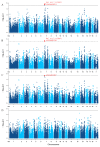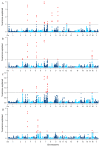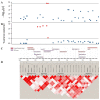Identification of Genomic Regions and Candidate Genes for Litter Traits in French Large White Pigs Using Genome-Wide Association Studies
- PMID: 35739920
- PMCID: PMC9219640
- DOI: 10.3390/ani12121584
Identification of Genomic Regions and Candidate Genes for Litter Traits in French Large White Pigs Using Genome-Wide Association Studies
Abstract
The reproductive traits of sows are one of the important economic traits in pig production, and their performance directly affects the economic benefits of the entire pig industry. In this study, a total of 895 French Large White pigs were genotyped by GeneSeek Porcine 50K SNP Beadchip and four phenotypic traits of 1407 pigs were recorded, including total number born (TNB), number born alive (NBA), number healthy piglets (NHP) and litter weight born alive (LWB). To identify genomic regions and genes for these traits, we used two approaches: a single-locus genome-wide association study (GWAS) and a single-step GWAS (ssGWAS). Overall, a total of five SNPs and 36 genomic regions were identified by single-locus GWAS and ssGWAS, respectively. Notably, fourof all five significant SNPs were located in 10.72-11.06 Mb on chromosome 7, were also identified by ssGWAS. These regions explained the highest or second highest genetic variance in the TNB, NBA and NHP traits and harbor the protein coding gene ENSSSCG00000042180. In addition, several candidate genes associated with litter traits were identified, including JARID2, PDIA6, FLRT2 and DICER1. Overall, these novel results reflect the polygenic genetic architecture of the litter traits and provide a theoretical reference for the following implementation of molecular breeding.
Keywords: SNP; SsGWAS; genetic variants; pig; reproductive traits.
Conflict of interest statement
The authors declare no conflict of interest.
Figures




Similar articles
-
Identifying SNPs and candidate genes for three litter traits using single-step GWAS across six parities in Landrace and Large White pigs.Physiol Genomics. 2018 Dec 1;50(12):1026-1035. doi: 10.1152/physiolgenomics.00071.2018. Epub 2018 Oct 5. Physiol Genomics. 2018. PMID: 30289746
-
Genome-wide association study reveals the candidate genes for reproduction traits in Yunong black pigs.Anim Genet. 2023 Jun;54(3):403-407. doi: 10.1111/age.13294. Epub 2023 Jan 17. Anim Genet. 2023. PMID: 36650110
-
Single step genome-wide association studies based on genotyping by sequence data reveals novel loci for the litter traits of domestic pigs.Genomics. 2018 May;110(3):171-179. doi: 10.1016/j.ygeno.2017.09.009. Epub 2017 Sep 21. Genomics. 2018. PMID: 28943389
-
Survey of SNPs Associated with Total Number Born and Total Number Born Alive in Pig.Genes (Basel). 2020 Apr 30;11(5):491. doi: 10.3390/genes11050491. Genes (Basel). 2020. PMID: 32365801 Free PMC article. Review.
-
Functional analysis of litter size and number of teats in pigs: From GWAS to post-GWAS.Theriogenology. 2022 Nov;193:157-166. doi: 10.1016/j.theriogenology.2022.09.005. Epub 2022 Sep 19. Theriogenology. 2022. PMID: 36209572
Cited by
-
Identifying selection signatures for immune response and resilience to Aleutian disease in mink using genotype data.Front Genet. 2024 Jul 12;15:1370891. doi: 10.3389/fgene.2024.1370891. eCollection 2024. Front Genet. 2024. PMID: 39071778 Free PMC article.
-
Genomic prediction accounting for dominance and epistatic genetic effects on litter size traits in Large White pigs.J Anim Sci. 2025 Jan 4;103:skaf004. doi: 10.1093/jas/skaf004. J Anim Sci. 2025. PMID: 39774780
-
Genome-Wide Association Study of Reproductive Traits in Large White Pigs.Animals (Basel). 2024 Oct 6;14(19):2874. doi: 10.3390/ani14192874. Animals (Basel). 2024. PMID: 39409823 Free PMC article.
-
Integrating genome-wide association studies and population genomics analysis reveals the genetic architecture of growth and backfat traits in pigs.Front Genet. 2022 Nov 25;13:1078696. doi: 10.3389/fgene.2022.1078696. eCollection 2022. Front Genet. 2022. PMID: 36506319 Free PMC article.
-
Weighted single-step genome-wide association study identified genomic regions and candidate genes for growth and reproductive traits in Wenchang chicken.Poult Sci. 2025 May;104(5):104733. doi: 10.1016/j.psj.2024.104733. Epub 2025 Jan 3. Poult Sci. 2025. PMID: 40203724 Free PMC article.
References
Grants and funding
LinkOut - more resources
Full Text Sources
Miscellaneous

